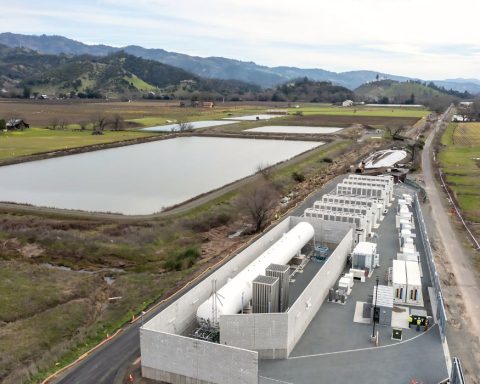James Hansen is director of NASA’s Goddard Institute for Space Studies and one of the world’s most respected climate scientists. Earlier this year he spoke at the prestigious TED conference in Long Beach, Calif., and stated what may seem a non-threatening fact: data collected from 3,000 Argo floats that record temperatures around the world’s oceans at different depths showed that the earth’s energy imbalance is precisely “six-tenths of a watt per square metre.” The calculation represents the extra energy, trapped in the earth’s atmosphere, which feeds global warming.
Then came Hansen’s kicker.
“That may not sound like much,” he remarked, “but when added up over the whole world… it’s the equivalent to exploding 400,000 Hiroshima atomic bombs per day, 365 days per year. That’s how much extra energy earth is gaining each day.”
According to Hansen, this may be an unfortunate precursor to what could amount to global sea-level rise of between one and five metres during this century.
Welcome to the new normal.
The new normal is a period of human history when natural disasters tied to climate change and political uncertainties related to economic and financial distress are all too common. Yet, it’s mainly the economic and financial crises we face that dominate the concerns of businesses, governments and citizens. After all, there are bond haircuts, eurozone panics, morally dubious investment banks, unmanageable consumer debts, employment uncertainties, and popular protests surrounding the “one per cent” to contend with.
But organizations and people tend to adjust in a reactive fashion to our predictably unpredictable business climate – what some experts describe as one of “permanent volatility” – and the deteriorating condition of our planet. To be proactive in this unstable operating environment would require that companies, as well as local, regional and national governments, prioritize resilience. Put another way, they need to build and retain the capacity to cope with various shocks in the system, including those related to energy, sovereign debt, currency markets, supply chains, consumer sentiment, employee concerns, as well as that contentious wild card, climate change.
Embedded in the concept of permanent volatility is the underlying risk of being blindsided by unexpected circumstances not just once, but again and again. Permanent volatility requires that organizations develop the capacity to be knocked down, to get up, and to take steps to re-stabilize. This is the rationale for why resilience is central to adaptation amid the 21st century’s “uncharted waters,” an era future historians may judge to have endured the greatest public loss of political, economic and financial flexibility in modern history.
Between 2007 and 2010, for example, funds allocated by the United States, European Union and other G8 nations to promote macroeconomic stabilization amounted to roughly $17 trillion, according to political economists Stephen Gill and Isabella Bakker at York University in Toronto. A significant percentage of these monies was dedicated to private-sector bailouts. These funds are unlikely to be recouped and thus may contribute to the public sector’s lack of financial flexibility in countering long-term risks, including the potential need to restructure long-term debt, as well as find additional funding for civil preparedness and infrastructure hardening related to climate adaptation.
Permanent volatility and resilience are two sides of the same coin. Heads is about potentially dramatic spikes in input costs and debt financing affecting social, economic and institutional spheres – the stuff of daily life. Tails represents the capacity of citizens, communities, institutions, businesses and governments to adapt to abrupt shifts in normalcy. A reduction of political, economic and financial flexibility caused by rising sovereign and consumer debt is one area that could negatively impact societal resilience. The other enemy of resilience is a lack of preparedness, where credible warnings from climate science, for example, are disconnected from political consensus and thus fail to elicit institutional commitment.
Gordon Price is director of the City Program at Simon Fraser University in Vancouver. As a six-time city councillor he’s acutely aware of the municipal planning process and how aligning long-term risk assessment with immediate political and economic reality is an increasingly tough challenge. About two years ago, Price started hearing about resilience in planning circles. “There was recognition that with climate change we won’t be able to stop or mitigate it,” he said. “So how do cities respond to circumstances that are locked in?”
One conceptual approach is the resilient city. According to Price, “a resilient city is probably more compact, with infrastructure that is newer and well maintained, thus more able to respond to emerging threats such as sea-level rise.” Price has also explored adaptation to change through methods such as scenario planning. “I’ve been to some scenario casting, looking at implications of the opening of the Northwest Passage (due to accelerated melting of Arctic ice),” he said. “You run into problems because there’s a trade-off around what you’ll do today for an unknown risk tomorrow. “Certain actions have been taken (to counter risk), but does it match up to the scale of the threat? Probably not.”
Indeed, the scale of the threat is staggering: the most credible recent estimate of climate change impacts between now and 2200 – globally, across water, health, infrastructure, coastal zones and ecosystems – equates financially to a stunning $1,240 trillion, according to estimates from a 2009 study by the International Institute for Environment and Development and the Grantham Institute for Climate Change, both based in London, England. The study estimated that spending $6 trillion on adaptation during that period would reduce impacts by $350 trillion. Clearly, adaptation pays off.
Like public institutions and government, corporations must manage trade-offs between market reality and long-term strategic planning. Based on my work in corporate futurism, some business strategists do understand the long-term threats posed by permanent volatility. Yet, they’re hamstrung because organizational resources are taken up in addressing today’s challenges surrounding volatility – not tomorrow’s. Thus, as one would predict, adapting to today trumps adapting to tomorrow.
Rob Abbott is a consultant based in Victoria who has worked with clients such as Walmart Canada on corporate sustainability initiatives. “The resilience discussion is dominated by the sectors you’d expect: academia, some non-governmental organizations and governments,” said Abbott. “The question when people talk about resilience is what they mean by it. At present, just as with sustainability, the concept risks being balkanized into economic resilience, social resilience, environmental resilience, and so on, just when we’re entering a period of long-term disequilibrium and should see the bigger picture.”
The challenge of addressing permanent volatility through resilience must not remain at the margins of business operations, but should extend to the core. For the past decade, Fortune 500 organizations, such as FedEx, UPS and Walmart, have emphasized adapting global supply chains to contingencies such as natural disasters, sea-level rise and regional political disturbances. Disasters such as the Fukushima Daiichi nuclear plant meltdown last year in Japan, for example, have raised fundamental doubts about the practicality of just-in-time manufacturing among both businesses and governments. This is in part because such a masterfully choreographed approach to manufacturing and delivering products to market isn’t resilient enough, even when unexpected events may limit disruption to only a few days.
“Have we put in the necessary investments that will allow us to adapt to the change and seize the opportunity for transformation?” asked Abbott. With regard to crisis and opportunity, he added, “It’s only an opportunity if we are prepared.” And that, truly, is the key to resilience. Are we – as individuals, communities, corporations, and municipal, regional and national governments – prepared for the contingencies for which we have solid evidence?
It appears we are not. The commitment isn’t there, and neither are the investments. Resilience is de rigueur in some quarters precisely because it indicates we’re facing dire conditions for which we’re not adequately prepared. The language of resilience is a warning sign that civil society must get ready to absorb large-scale setbacks to business – and to life – as usual.
A time of permanent volatility is, in essence, a time of constant readiness, of tapping into the deepest well of strength and wherewithal that would empower highly intelligent and humane responses to catastrophic disruptions.
“Few I talk with in the corporate movement understand resilience in the long term,” said Gregory Greene, a documentary filmmaker and resilience commentator who worked on a project called “Confronting Comfort” for the BMW Guggenheim Lab, a think tank and mobile laboratory aimed at stimulating discussion and ideas around environmental and social responsibility. “You have to lay out the ideas and the context, so when an oil or financial shock comes, you have the people with the ideas and the answers. In that moment, you can implement some of those ideas.”
Greene may be right. The wise only speak when people will listen. And many of us, individuals and organizations alike, aren’t ready to listen. Those who are up for listening may not be in a position to act. Either way, little progress will be made until a serious strategic conversation about resilience takes place and is acted upon.
The new normal, after all, is here.







